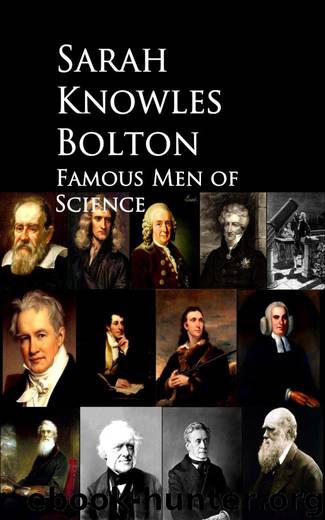Famous Men of Science by Sarah Knowles Bolton

Author:Sarah Knowles Bolton [Bolton, Sarah Knowles]
Language: eng
Format: epub
Published: 2016-07-30T00:00:00+00:00
In the year 1835, having been appointed professor of the Literature of the Arts of Design in the New York City University, he took rooms in the third story of the university building. "There," he says, "I immediately commenced, with very limited means, to experiment upon my invention. My first instrument was made up of an old picture or canvas frame fastened to a table; the wheels of an old wooden clock, moved by a weight to carry the paper forward; three wooden drums, upon one of which the paper was wound and passed over the other two; a wooden pendulum suspended to the top piece of the picture or stretching-frame, and vibrating across the paper as it passes over the centre wooden drum; a pencil at the lower end of the pendulum, in contact with the paper; an electro-magnet fastened to a shelf across the picture or stretching-frame, opposite to an armature made fast to the pendulum; a type rule, and type for breaking the circuit, resting on an endless band, composed of carpet-binding, which passed over two wooden rollers, moved by a wooden crank, and carried forward by points projecting from the bottom of the rule downward into the carpet-binding; a lever, with a small weight on the upper side; and a tooth, projecting downward at one end, operated on by the type; and a metallic fork, also projecting downward over two mercury-cups; and a short circuit of wire, embracing the helices of the electro-magnet connected with the positive and negative poles of the battery, and terminating in the mercury-cups."
Morse was now so poor that he bought his food in small quantities from some grocery, and prepared it himself. He says, "To conceal from my friends the stinted manner in which I lived, I was in the habit of bringing my food to my room in the evenings, and this was my mode of life for many years."
In this year, 1835, says Professor Horsford, "Morse made his discovery of the relay, the most brilliant of all the achievements to which his name must be forever attached. It was the discovery of a means by which the current, which through distance from its source had become feeble, could be reënforced or renewed. This discovery, according to the different objects for which it is employed, is variously known as the registering magnet, the local circuit, the marginal circuit, the repeater, etc. It made transmission from one point on a main line through indefinitely great distances, and through an indefinite number of branch lines, and to an indefinite number of way-stations, and registration at all, possible and practicable, from a single act of a single operator."
Poor, longing for money to carry forward his plans, despondent lest some one think out a kindred machine and supplant him, Morse was also suffering from injustice in his art work. Our government having offered to American artists commissions to paint pictures for the panels in the Rotunda of the Capitol, the friends of Morse urged
Download
This site does not store any files on its server. We only index and link to content provided by other sites. Please contact the content providers to delete copyright contents if any and email us, we'll remove relevant links or contents immediately.
Cecilia; Or, Memoirs of an Heiress — Volume 2 by Fanny Burney(31871)
Cecilia; Or, Memoirs of an Heiress — Volume 3 by Fanny Burney(31852)
Fanny Burney by Claire Harman(26526)
We're Going to Need More Wine by Gabrielle Union(18967)
Plagued by Fire by Paul Hendrickson(17331)
All the Missing Girls by Megan Miranda(15565)
Cat's cradle by Kurt Vonnegut(15182)
Bombshells: Glamour Girls of a Lifetime by Sullivan Steve(13972)
Leonardo da Vinci by Walter Isaacson(13181)
For the Love of Europe by Rick Steves(12952)
4 3 2 1: A Novel by Paul Auster(12281)
Adultolescence by Gabbie Hanna(8857)
The remains of the day by Kazuo Ishiguro(8819)
Note to Self by Connor Franta(7621)
Diary of a Player by Brad Paisley(7487)
Giovanni's Room by James Baldwin(7189)
What Does This Button Do? by Bruce Dickinson(6134)
Ego Is the Enemy by Ryan Holiday(5294)
Born a Crime by Trevor Noah(5293)
